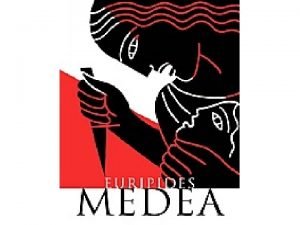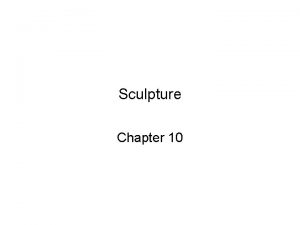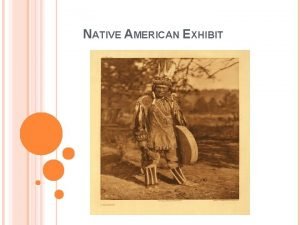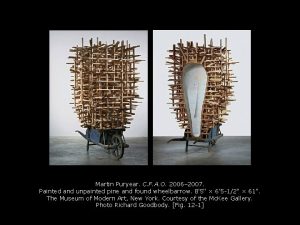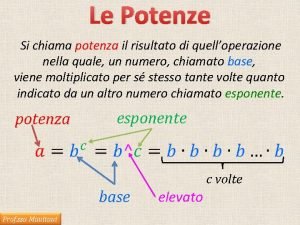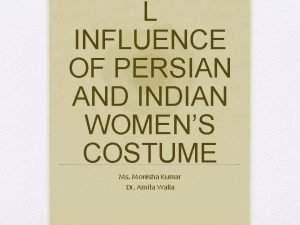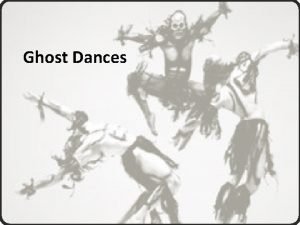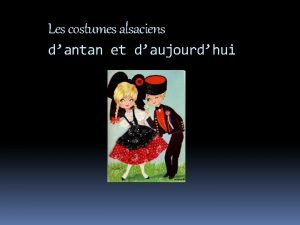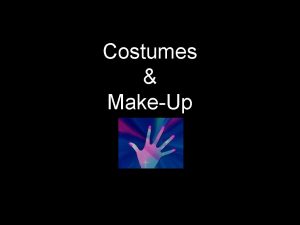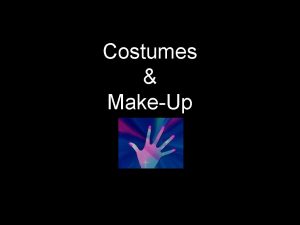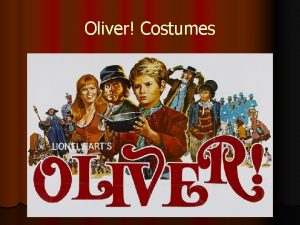Costumes Onkos headdress which was used to elevate












- Slides: 12


Costumes: Onkos: • headdress which was used to elevate height and make them more visible to the audience. Female costumes: • Male actors played female parts because women weren’t allowed to participate in theatre. • The male actors wore a “prosterneda” (a wooden structure in front of the chest, to imitate female breasts) and “progastreda” in front of the belly.

Seating arrangements: • It was divided in two Diazoma: the upper and lower. • Staircases separated theatron into wedge shaped sections. • The front seats were called Proedria and were reserved for officials and priests. • The most honorable spectator of theatre was the priest of Dionysus, who was sitting in a throne made of marble.

• There was a special block of seats reserved for members of the boulê (the 500 -member Executive Council of the Assembly). • Ordinary citizens might have been assigned seats on the basis of the ten Attic tribes. • Theatre tickets were often stamped with a Greek letter that apparently referred to a specific wedge of seats. • The audience were primarily adult male citizens of Athens, with perhaps a sprinkling of resident foreigners (metics);

Euripides • Born in Salamis in 480 - 406 BC • last of the three great tragedians (Aeschylus and Sophocles). • wrote ninety-five plays (approx); 18/19 have survived (more than other two!) • reshaped the structure of tragedy by portraying strong female characters, intelligent slaves and by making fun of many heroes of Greek mythology. • First competed in City Dionysia in 455 BC (3 rd!). • 441 BC - came first (won four times altogether). • Despite being not as successful in winning (Aeschylus = 13; Sophocles = 18) his plays were more popular. • Euripides' greatest works include Alcestis, Medea, Trojan Women, and The Bacchae. • Euripides focused on the realism of his characters, for example Medea is a realistic woman with recognizable emotions and is not simply a villain – we understand her actions.

‘Medea’ by Euripides • Based on the myth of Medea and Jason. • Medea is the lead role (protagonist) and a barbarian (aggressive and uncultured). • Medea has been betrayed by her husband the play focuses on her revenge.

Jason and the Golden Fleece During his quest to gain the Golden fleece, Jason had to complete three tasks put to him by King Aeetes. Realising that he would fail, Jason fell into a depression. The Gods intervened and made Aeetes daughter, Medea, fall in love with Jason. She helped him complete the tasks and when they had acquired the fleece, Jason returned to Corinth, taking Medea with him. Aeetes chased them, so Medea killed her brother and threw bits of his body into the sea to distract her father. Medea and Jason escaped and were married in Corinth.

Medea • • • Jason betrays Medea by abandoning her for another woman. He leaves her to marry Glauce, the daughter of King Creon, fearing what Medea will do, tries to send her into exile. Medea begs him to stay, which he allows. Medea begins plotting her revenge on Jason by deciding to kill King Creon, Glauce and her own children. • Glauce is killed by a poisoned dress; Creon dies by the same poison as he tries to help her. • Medea murders her children (off stage). • At the end of the play, Medea faces a distraught Jason.

Structure of a Tragedy • Prologue: – an opening to establishes the setting and background. – Can mention an earlier story that ties into the main one e. g. Jason and the Golden Fleece; Jason’s betrayal. • Chorus and Choral Odes: – communicate in song and altogether. – Chorus are used as a final curtain – they signify the end of the play/scene. – Choral odes (songs sung by the chorus) separated each ‘scene’ (episode). – These songs were known as a STASIMON and talked about what has happened in the episode before.

• Entrance of chorus: – Enter chanting a song called the PARADOS. – The Parados repeats what has been said in the prologue. • Episode: – Each Greek tragedy is split into 3 -5 episodes (scenes). • Agon: – an AGON is a formal debate between the main characters (e. g. between Jason and Medea). – The chorus act as a judge.

• Messenger’s speech: – This speech describes off stage action e. g. any deaths, mutilations etc that can’t be seen on stage. – A messenger will inform us about the violent action that has taken place off stage. – It is the only way an audience would know what has happened.

